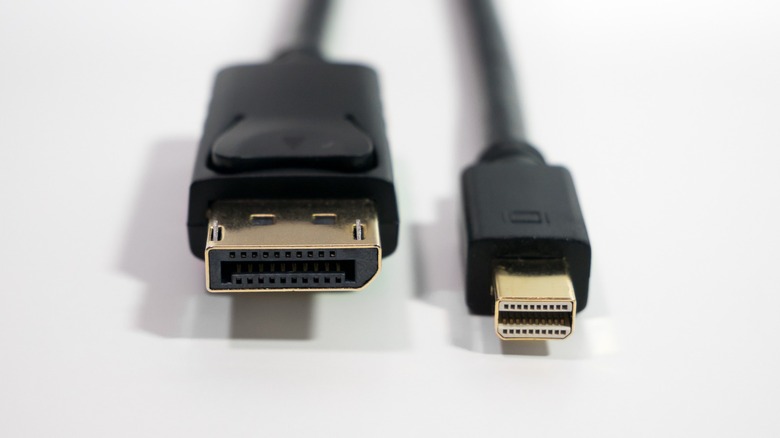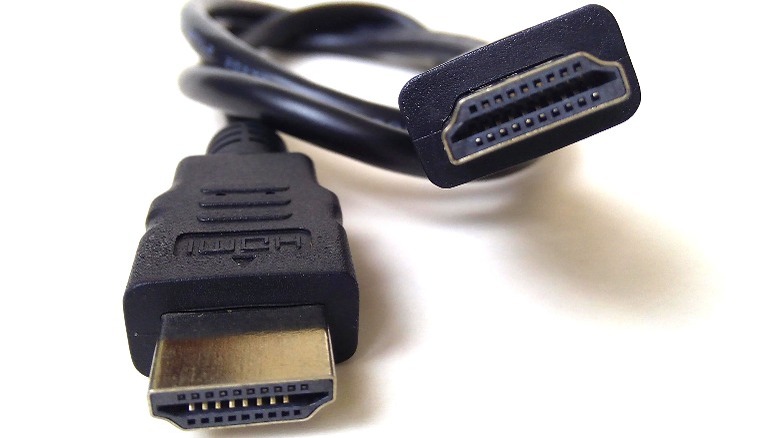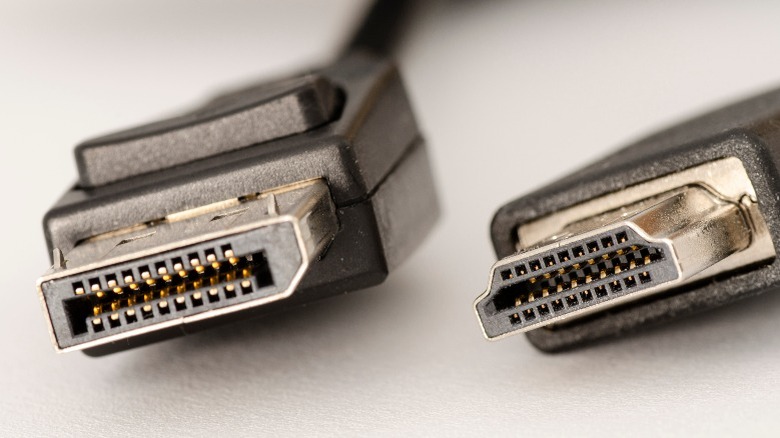What Is A DP Cable, And Is It Different From HDMI?
Some of the most popular cables today include DP and HDMI cables. But what exactly is the difference between the two, and is one better than the other? First of all, DP stands for DisplayPort, while HDMI means High-Definition Media Interface. Both types of cables connect technology, like computers and gaming consoles, to other devices like monitors and TVs. Both DisplayPort and HDMI cables facilitate the transfer of audio and video from one device to another. However, the ways these cables work and their capabilities differ slightly.
DP cables were designed to replace the older DVI, LVDS, and VGA cables that dominated the tech industry during the '80s, '90s, and early 2000s. DisplayPort cables are more complex and provide a series of improvements when compared to older cable types. Some of the major benefits of a DP cable include compatibility with high-resolution monitors, the ability to send both audio and video through a single cable, and support high refresh rates, resulting in a crisper images.
DisplayPort cables work similar to Ethernet cables because of the way they send data packets between devices. This feature allows DP cables to be highly efficient and makes them ideal for high-speed computers. While computers are the most common application for DP cables, they're also used for DVD players, Blu-Ray players, and gaming consoles. That said, remember that DP cables do not support Ethernet and cannot be used to connect devices to the Internet.
How are DP cables different from HDMI cables?
HDMI cables are also used to send video and audio between two devices but are often more versatile than DP cables. The HDMI creators intended for the cable to function as a universal tool for connecting devices, serving as a one-size-fits-all solution for connecting devices. Since then, the HDMI cable has become ubiquitous in the tech world. While the most common applications for HDMI cables include connecting devices like gaming consoles, TVs, Blu-Ray players, computers, and monitors. The cable's uses are so vast, you can even find them in automotive and commercial applications.
HDMI cables are available in various types, styles, and capabilities. Basic HDMI cables can transmit audio and video at resolutions up to 1080i and at speeds up to 5 gigabits per second. Some HDMI cables are designed for high speeds and resolutions up to 8K, while others are built specifically for automotive use and feature reinforced heat shielding to protect them from harsh conditions and high engine temperatures.
In contrast, there are two types of DisplayPort cables: standard and DisplayPort 2.1. The cables also come in standard and Mini DisplayPort sizes. DisplayPort 2.1 is the more modern version, capable of higher bandwidth levels and compatible with advanced monitors and displays. The standard connections are irregular in shape, while the mini versions look similar to Thunderbolt cables. Regardless, both standard and mini DP cables have 20 pins and the same capabilities.
DP vs. HDMI: Which should you buy?
Whether you need a DisplayPort or an HDMI cable depends mainly on what you're connecting. DP cables are most frequently found in high-end computer setups, particularly gaming computer setups. This is partially due to DisplayPort's compatibility with both Nvidia's G-SYNC and AMD's FreeSync. It also helps that DP cables are ideal for multi-monitor setups, like those favored by gamers and streamers.
HDMI cables, on the other hand, are more versatile but limited in other ways. These cables support AMD's FreeSync technology but aren't compatible with Nvidia's G-SYNC. However, HDMI cables feature many capabilities that DP cables don't. Most new HDMI cables support built-in Ethernet, allowing users to connect devices to the Internet without extra connections. Furthermore, HDMI cables provide CEC support, meaning they can transmit and control audio signals using a remote. That feature makes HDMI cables the preferred choice for audio and home entertainment systems. Finally, HDMI cables may be ideal for situations requiring more length. DP cables are designed to function optimally at lengths under 3 meters, while HDMI cables don't have a specified ideal length.
Generally, DisplayPort cables are the better choice for high-speed gaming PCs or Nvidia graphics card users, while HDMI is ideal for connecting various technologies like TVs, gaming consoles, or media players. That said, these cables share many features, and there are numerous situations where both are appropriate. Remember, do your own research and check devices to determine which cable connections are supported.


